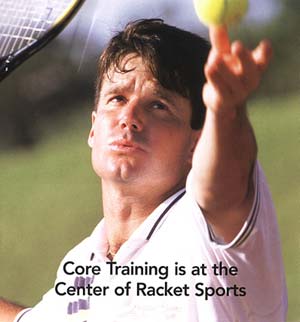INHALE/EXHALE: THE HAMPTONS GUIDE TO SPORTS & FITNESS, Spring/Summer 2003 Core Training is at the Center of Racket SportsBY PAUL FREDIANI
Core Training is at the Center of Racket SportsBY PAUL FREDIANIRacket sports such as tennis, squash, racquetball and badminton require strength, flexibility and cardiovascular fitness. They all demand a burst of energy-fast, explosive stop-and-go movements and the ability to change direction quickly-with the body extended to its full ranges of motion. So get in shape before you play.
The American Academy of Orthopaedic Surgeons recommends warmups and stretches before any strenuous physical activity to reduce wear and tear on joints and the possibility of injury. A good warm-up will increase heart rate and blood flow, which in turn will increase body temperature and provide improved elasticity of connective tissue, tendons, ligaments and cartilage; increased oxygen to deliver nutrients to muscles and synovial fluid, which lubricates the joints; and increased reaction time and better coordination by engaging the neuromuscular (balance) system.
Stretching increases the range of motion and smoothness of joint movement to improve muscular balance and reduce low back pain by increasing flexibility of the quads, hamstrings, hip flexors and shoulder girdle. This helps to relax and elongate muscles. A good flexibility program can help ensure good posture, which not only reduces the risk of overuse injuries but also increases efficiency of movement.
"Core training" is the buzzword in the fitness industry. It involves the pelvis and the lumbar, thoracic and cervical spine, but it is better known by the muscles that connect them--the abs and back. It is where movement is generated, the center of balance. A strong core enhances the body's ability to stabilize, accelerate and decelerate all explosive movements. In other words, to quickly recover from, and set up for, the next shot.
An excellent way to condition the functionality of the core is to exercise the muscles the same way they are used in play. Stand-up exercises will strengthen and warm up the core through the kinetic chain from feet to shoulders.
The following Net Flex exercises, without medicine balls, are excellent for warming up before stretching. With the weight of medicine balls (or dumbbell), they will develop strength (legs, hips, shoulders and torso) in all planes of movement and will enhance the most powerful movements for athletes: the shoulder to opposite hip rotation, as well as the serve, backhand and forehand.
AX CHOPS
Start by using a 3-pound medicine ball (or dumbbell). Stand with feet a shoulder width apart, knees slightly bent. With the weight in hand, bring it over the right shoulder then swing it diagonally down past the left knee. Do a set of 10 on each side with downward acceleration, then a set of 10 on each side with upward acceleration.
Again, standing, do a set of ax chops starting with the hands over the head and swinging the weight through the legs. Do 10 with downward acceleration, then 10 with upward acceleration.
ROTATIONS
Hold the weight in both hands with arms extended in front of you. Rotate horizontally to the left, then to the right. Accelerate in both directions. While turning left rotate the right foot, when turning right rotate left foot. Keep your hips facing forward and rotate the shoulders.
As you get stronger and can stabilize the movements, you can increase the weight or do the exercises standing on one foot.
Warning: Do not proceed with this workout without consulting your physician.
PAUL FREDIANI is a personal trainer and author of several best-selling fitness books available at Amazon.com, including Net Flex, on flexibility and conditioning for tennis. Paul is an E+ trainer at Equinox in New York City and is certified by ACE, ACSM and is a medical exercise specialist. He sits on the board of the U.S. Surfing Federation Sports Medicine Committee.
